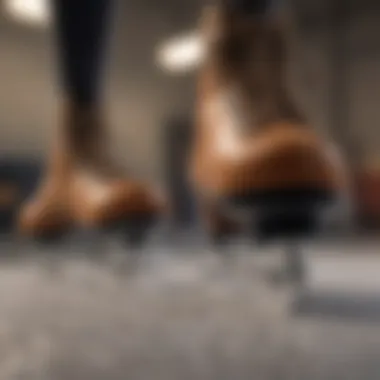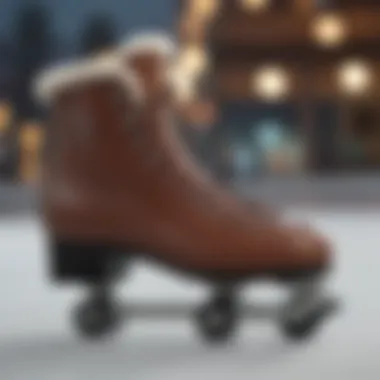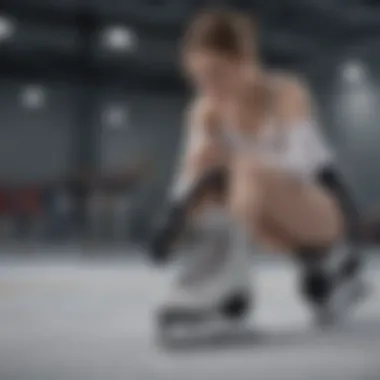The Ultimate Guide to Ladies Figure Skates: Features & Tips


Intro
Ladies figure skates hold a special place in ice skating, blending artistry with athleticism. They are not merely footwear but essential tools that influence a skater’s performance and comfort. As the sport gains popularity, understanding the subtleties of these skates becomes crucial for enhancing skills and enjoyment on ice.
The key features of ladies figure skates vary widely. Different skating styles require specific designs that cater to individual needs. As we unravel the intricacies of these skates, we will cover their prominent characteristics, varied types, and how they impact the skating experience while also considering the skater's expertise level—from beginners aiming to find their balance to competitive professionals seeking to perfect their craft.
This guide serves to offer insights into the materials traditionally used, technological advancements that have shaped modern skates, maintenance practices, and crucial advice on selecting the right pair. Attention will be paid to the unique needs of all skaters, providing a foundation for informed decisions that accommodate personal preferences and objectives.
Extreme Sport Overview
In unveiling the world of ladies figure skates, it's important to position this sport against its historic backdrop and evolving nature.
While many perceive figure skating as purely an artistic performance, it embodies elements of strength, balance, and technical precision. The origins of modern figure skating trace back to the early 19th century, where its foundations were solidified in both recreational activities and competitive standards.
The fundamental equipment required for figure skating, of course, is the skates themselves. Unlike other ice sports, ladies figure skates are uniquely engineered to support specific movements such as spins, jumps, and footwork. A key differentiating factor includes the blade—a narrow design allowing for intricate maneuvers,
Here are essential safety tips for those engaging in figure skating:
- Always wear appropriate protective gear, such as wrist guards and kneepads.
- Regularly inspect skates for any wear or damage before each use.
- Practice in safe environments, enhancing your skills progressively.
- Consider taking lessons from certified instructors to ensure proper technique and form.
Skating is mesmerising yet the physical demands require skaters to balance their movements to optimize performance. The statistical growth of figure skating participants reflects its growing appeal, inspiring both women and men to explore the discipline,
Some underlying statistics include:
- Yearly participation rates, indicating a positive trend in skater demographics.
- Injury rates associated with the sport, emphasizing the significance of safety practices.
This overview provides perspective as we move forward. Factors influencing a skater's choice in gear need to be examined thoroughly, requesting attention to the technological aspects shaping today’s most revered ladies figure skates.
Intro to Ladies Figure Skates
In the realm of figure skating, the choice of skates plays a crucial role in a skater’s performance and experience. Ladies figure skates are designed with unique specifications that cater to the specific needs of female skaters, making them an essential part of the craft. Understanding the importance of quality skates is vital, as the right equipment can significantly enhance a skater's ability, safety, and enjoyment on the ice.
Understanding the Importance of Quality Skates
Quality skates are paramount for any aspiring or professional figure skater. First, they provide the necessary support to prevent injuries. Well-constructed boots, blades, and materials can help improve balance on the ice. A good fit is essential. Too tight can cause pain; too loose can lead to control loss, impacting performance.
Moreover, quality skates translate to better performance. High-quality blades ensure sharper edges and enhanced glide, resulting in improved speed and fluidity in movements. Dances, jumps, and spins require a precise interaction between the skate and the ice. Therefore, ladies figure skates overseas strong relationships between functionality and craftsmanship.
In summary, investing in good-quality skates is an investment in the skater's future. Performance matters, and so does comfort.
An Overview of Figure Skating
Figure skating is both an art and a sport, requiring a combination of skill, aesthetic presentation, and technical abilities. With different disciplines such as singles, pairs, and ice dance, each skater’s needs may vary dramatically.
The grace on the ice comes from rigorous training. Skating allows individuals to express artistry while mastering complex techniques. A skater's journey usually begins with recreational skating before competing or specializing. Fundamental techniques lay the groundwork for more advanced maneuvers, making the selection of appropriate skates imperative from the outset.
When beginning this journey, understanding various skating styles—like freestyle or dramatic—helps in aligning with specific skate features, which also shapes the overall skating experience. Each skilled performance on the ice relies heavily on equipment quality, making it necessary to focus on not just the skill set but also the design and construction of the skates used. Thus, assessing ladies figure skates evolves into a nuanced endeavor for those deeply engaged in the sport.
Key Features of Ladies Figure Skates
The construction and characteristics of ladies figure skates greatly impact performance, comfort, and longevity. Key features set apart different skates suited to meet specific needs. Understanding these elements can help skaters make a well-informed choice based on their unique skating styles, preferences, and levels of expertise.
Blade Types and Their Impact on Performance
Blades are perhaps the most prominent feature of figure skates. They come in various types tailored for proficiency in precision movements and stability. Common blade distinctions include the blade height, shape, and material.
Types of Blades


- Figure Blades: These blades are essential for mastering jumps and spins. Their design allows for deeper concavity, enabling skaters to achieve desirable edges.
- Groomed Blades: Designed predominantly for a varied set of techniques, groomed blades are used to adapt practice for both choreography and performance.
- Specialized Blades: For experienced skaters, these blades cater to advanced techniques that demand specific styles.
Impact on Performance
Selection of the blade influences performance significantly. A well-matched blade supports necessary maneuvers, while incorrect selection may hinder practice progress. It’s vital to grasp one's technique proficiency and how corresponding blades amplify both speed and agility.
Boot Construction and Support Levels
A well-structured boot is key to sustaining performance during skating sessions. Strong support levels are integral in protecting the foot and ankle from injury while offering a layer of precision control to movements.
Key Boot Features
- Materials: Boots primarily come in leather or synthetic variants. Leather offers rigidity and breathability, whereas synthetic options lend flexibility.
- Support Levels: Different support levels cater to varying stages of skaters often categorized as soft, medium, or stiff boots. Softer models benefit beginners with more movement, whereas stiffer versions provide robust support for advanced athletes.
Each skater's choice of boot rigidity should correspond to their skill set; using an appropriate support level is crucial to prevent discomfort or enhance stability during maneuvers.
Lining and Comfortable Fit
Comfort when skating directly correlates with the type of lining and fit of the skates worn. Skaters ought to select skates that provide an ideal fit to enhance experiences both on and off the ice.
Importances of Proper Lining and Fit
- Lining Materials: Common linings are made from moisture-wicking fabrics that help reduce sweat accumulation, thus balancing temperature and comfort.
- Fit Adjustments: A good fit means the foot does not slide around within the boot. Personalized fittings are available from many retailers that ensure bespoke configuration as per foot shape and size.
Achieving comfort improves performance longevity, thus fostering a smoother skating journey.
Investing in quality blades, supportive boots, and the right fit will elevate any skater's performance considerably, more fluid movements transcend into athletic excellence.
Types of Ladies Figure Skates
Types of ladies figure skates serve a fundamental purpose in the sport. Understanding the distinctions between them is crucial for skaters aiming to optimize their performance based on their objectives. The right type of skate not only enhances ability but also influences safety and overall enjoyment on the ice.
Recreational Skates Versus Competitive Skates
Recreational skates are designed for leisure and casual use. These skates focus on comfort and stability, making them ideal for skaters who enjoy moving around on the ice but do not engage in advanced maneuvers. They typically have a softer boot construction and a broader blade for improved balance. Control is vital, and recreational boots often provide extra padding for prolonged relief during use.
On the other hand, competitive skates are tailored for higher-level performance. The boots are stiffer and more rigid for better ankle support and response. Skaters competing need maximum control over their movements, so the blade types used are also specific and more sensitive to changes in weight distribution. Thus, participant must chose with their skill level and objectives in mind. More often, competitive skates feature unique designs tailored around achieving harder and complex moves.
Specialized Skates for Different Techniques
Within competitive and recreational categories, skaters may seek specialized options. For instance, freestyle skates cater to those interested in jumps and tricks. These styles often have distinct blade characteristics to facilitate spring and grip, essential for performing stunts flawlessly.
Ice dance skates, in contrast, focus more on elegance and movement fluency than on mere performance metrics. The design often integrates enhanced blade footing and lighter boot design to allow skaters to execute intricate footwork dances. Similarly, artistic skates combine elements from both freestyle and ice dance, as artistic expression plays a vital role in performances.
From beginner to advanced levels, the distinctions in skates can significantly influence performance and physical experience. It is adived to assess skating goals quietly before making a purchse to invest in (not future options!).
"Choosing the right type of ladies figure skates is crucial because they enhance both safety and enjoyment on the ice."
Overall, the choice between recreational, competitive, and specialized skates cannot be made lightly. Skaters should continually evaluate their needs and strive for the appropriate fit for their style of winter sport. It leads to better asured skills and enjoyable experiences in skating.
Selecting the Right Ladies Figure Skates
Selecting the appropriate ladies figure skates is crucial for anyone looking to improve their performance on the ice. The right pair enhances not only your comfort but also your skills, allowing you to execute movements with precision. Importantly, the selection process considers multiple personal factors, including your experience level, training intensity and personal skating style.
Assessing Skill Level and Intended Use
Identifying your skill level is the first step when searching for the perfect pair of skates. Beginners should focus on recreational skates, which prioritize comfort and support. Features such as soft boots and lightweight materials allow for ease of movement, making entry into the sport smoother and more enjoyable.


For intermediate to advanced skaters, a significant upgrade in technologies and functionalities can be needed. Competitive skates typically provide stronger ankle support, rigid materials, and sharper blades. This type of footwear enhances the energy transfer necessary for executing jumps and spins, essential for performance.
Before making a selection, consider your intended use for the skates. This may be corellated with where you plan to skate—sometimes rink conditions may be different based on skill levels and chosen activities. Using skates designed for show programs may not work as effectively on less ideal ice surfaces.
Factors to Consider Before Purchase
Other essential factors must be evaluated thoroughly prior to acquiring your figure skates. Important aspects include the following:
- Fit and Sizing: Off-the-shelf sizes may not work for everyone. A proper fitting pair ensures comfort, reduces foot pain and enhances performance.
- Boot Stiffness: The stiffness of the boots correlates with skill level and types movements a skater plans to perform. Softer boots suit beginners, while rigidity is advantageous for advanced, aggressive skating maneuvers.
- Blade Quality: Different blade styles offer various performances on the ice. Ensuring they align with your skill requirement is very necessary. Some blades are designed for speed and agility while others enhance balance and control. Additionally, the right blade maintenance can significantly improve performance.
- Budget: Cost can directly correlate with the quality of material and technological features. It is vital to align budget expectations with necessary features.
Choosing the right ladies figure skates must be a well-informed decision. Each individual's comfort and purpose for using the skates plays a significant role. With thorough assessment and consideration of the discussed factors, your skating pursuits can truly benefit.
Materials Used in Figure Skates
Understanding the materials used in ladies figure skates is crucial for improving performance, comfort, and durability. Skaters must discern the characteristics that different materials bring to the table. Whether choosing classic leather or modern synthetics, the choice of material impacts every aspect of skating, from flexibility to support.
Exploring the Different Types of Leather
Leather has been a traditional material in figure skates for ages. Generally renowned for its durability and comfort, the types of leather vary significantly. High-quality leather often molds to the foot over time, providing a custom fit.
Some skates use full-grain leather, which offers superior durability and breathability. It tends to last longer under rigorous use. However, it's often heavier. Top-grain and split leather are other options that provide varying balances between weight and performance. They are typically softer and lighter but may not endure as long.
Keep in mind that quality leathers can demand more care. They require regular conditioning to keep them flexible and maintain their performance integrity. Consider how often and in which types of conditions the skates will be used when selecting leather.
Synthetic Materials: Pros and Cons
Synthetic materials, like nylon or other polymers, have become increasingly common in the production of figure skates. They are appealing for several reasons. First, synthetic materials tend to be lighter than full-leather options. This facilitates easier movement on the ice.
Below are some major pros:
- Lightweight: Less mass translates to quicker maneuvers.
- Water-resistant: Many synthetic materials offer better resistance to moisture, making them suitable for humid conditions.
- Easy to maintain: They usually only require a wipe down after use, simplifying care routines.
However, synthetic materials may have their downsides:
- Reduced breathability: They don’t always allow for as much airflow as leather, potentially leading to heat build-up.
- Less longevity: While they may hold up well in some scenarios, they may not provide the same lifespan as higher-quality leathers under excessive strain.
Both leather and synthetics offer unique advantages, depending on the skater's preferences and needs. Evaluating the specific conditions they will face can guide skaters toward an informed choice on material.
Key point: The success of figure skating can be influenced heavily by the material used in their skates. Choosing the right foundation is paramount for optimal performance on the ice.
Technology and Innovations in Figure Skating
In the ever-evolving world of figure skating, technology and innovations play a crucial role in enhancing both performance and safety. Advances in design and materials contribute significantly to the efficiency of the sport. As athletes push their boundaries, skates continually adapt to meet new demands. The introduction of cutting-edge technologies each season brings substantial benefits.
The Role of Tech in Modern Skates
Modern figure skates are no longer just about blades and boots; they are intricate systems built for optimum performance. Computer-aided design (CAD) allows manufacturers to fine-tune every aspect of a skate. From blade curvature to boot fit, technology ensures that skates provide consistent and reliable performance.
One major advancement is the use of adaptive materials, which change in response to pressure and temperature. This enhances comfort and support, allowing athletes to maintain peak performance. Furthermore, integrated heat-molding tech helps to create a custom fit faster than traditional methods. Athletes spend less time adjusting their skates and more time on the ice.
Key Points on Modern Skate Tech:
- Enhanced materials for better support and flexibility
- Custom-fit technology for increased comfort
- Streamlined design to reduce weight
In addition to performance enhancements, smart fabrics are gradually entering the scene, targeting moisture management and temperature regulation. This ensures that skaters can remain focused and comfortable without distractions.
Safety Features and Enhancements


Safety is paramount in figure skating, and recent tech innovations focus on protecting skaters from injuries. Modern skates now include improved shin guards and reinforced blades designed to reduce risks during falls or collisions. Athletes can enjoy their passion more confidently, knowing safety mechanisms are in place.
Key Safety Enhancements Include:
- Shock-absorbing soles to minimize impact damage
- Reinforced uppers to protect against toe injuries
- Integrated locks to secure blades in place securely
The benefit of these innovations cannot be understated. They not only help to reduce injuries but they also allow athletes to push their limits. There is confidence as they perform challenging routines that require precision and courage.
Investing in advanced technology means better safety and a pathway to skill mastery.
As we watch figure skating grow, let's recognize that technology is a key player in redefining what is possible. For both beginners and professionals, these advancements shape a safer, more effective training environment, creating more skilled athletes in the process. Experimentation and growth will continue, leading to an exhilarating future for figure skating.
Maintenance and Care for Figure Skates
The longevity and performance of ladies figure skates hinge upon proper maintenance and care. Just like any athletic equipment, these skates can wear down if not properly cleaned and stored. Adequate care not only is meaningful to maintain the skates themselves but also ensures the safety and comfort of the skater. Recognizing the necessity of consistent attention spanning from everyday cleaning to storing procedures allows both new and seasoned athletes to prolong the lifespan of their skates.
Routine Care and Cleaning Practices
Maintaining your figure skates involves regular care routines that can make a significant difference over time. After each skating session, check the skates for dirt, dust, or ice buildup. Wiping the blades with a soft cloth will prevent rust and discoloration due to moisture.
You might want to let your skates dry after use before putting them away. Pat the blades dry, allowing them to air out for a few moments. Many recommend removing any protective covers post-session to allow the entire skate – including liners – to breathe.
Here are a few essential practices for maintaining your skates daily:
- Dry enclosed gently: After each use, dry ins replaces using an absorbing cloth.
- Clean the blades rigorously: Regular blade polishing is crucial to maintain an appealing finish.
- Use specialized solutions: Distribution of cleaner formulated strictly for blades minimizes buildup.
Remember not every cleaning solution is skater-friendly. Engaging in negliagance may reult in permanent damage. It's advisable to use high quality products selectively designed for figure skating.
Storage Solutions for Longevity
How one stores their figure skates can immensely affect their durability. Finding a designated, temperature-controlled spot for your skates reduces the chances of damage due to excessive heat or moisture. Long exposure to extreme conditions leads to potential degradation of the boot and blade materials.
Here are helpful storage tips for optimum preservation:
- Keep off the ground: Utilizing a shelf or peg system eases contamination from ground debris.
- Fresh air circulates: Choose an area that feels ventilated, sustaining air circulation prevents mildew in damp conditions.
- Maintain blade covers: Always ensure blade guards or soakers are in-place to prevent scratches or dents.
Improper storage may prompt deterioration, leading to expenses for replacement equpiment. Examine the state before placing them contention before framing the frames or points of desired impact, where they deserves appropriate wraps or guards!
Take great care of your skates; they're fundamental for your performance and safety.
By adhering to these maintenance and care guidelines, skaters can rest assured their equipment will remain in prime condition, ready for every performance and practice. In the competitive world of figure skating, few things substitute the advantage granted by well-maintained equipment. A systematic part of life on the rink, the vigor and longevity they maintain enables a consistent journey towards mastery.
Culmination and Future Trends
The journey through the world of ladies figure skates culminates in understanding emerging trends and future developments. As the sport evolves, so does the skates' design and technology, which are paramount in supporting athletes' progression. Resilient designs combined with advanced technology can elevate skating experiences. Hence, assessing what these trends mean for performance is crucial for all skaters, from novices to experts.
Predicted Developments in Figure Skate Design
Advancements in materials and engineering concepts will likely redefine the landscape of figure skating gear. For instance, the introduction of newer composite materials promises a blend of lightness and durability unheard before. These moguulll pliable materials facilitate quick adjustments, thereby enhancing performance during critical moments. Innovations, such as heat-molding boots, offer a perfect personalized fit, reducing discomfort often experienced in rigid designs. This practice might grow as a more standard option in coming years.
"Design is not just what it looks like and feels like. Design is how it works." – Steve Jobs.
Also, the integration of smart technology stands practical as skating matures. Skates fitted with sensors to track performance metrics can provide feedback in real time, aiding skaters’ technique improvements.
Sustainability is another aspect capturing attention. Developers are inclined to focus on eco-friendly materials and production techniques. As awareness rises regarding environmental impacts, the combo of technology and conscientious design will take center stage in the designing future skates.
Final Thoughts on Choosing the Best Skates
The market is filled with various options for ladies figure skates, which can often confuse potential buyers. Before making a purchase, it is vital to consider detail-oriented aspects to match skates with individual needs. Price and appearance hold influence, but skaters should prioritize fit, blade type, and specifies related to their skating level.
Key considerations include:
- Skill Level: A solid foundation is vital when choosing entry-level vs competition-oriented skates.
- Comfort: Padding and boot shape significance are non-negligible. Allocate timeframe figuring skin fittings.
- Maintenance Needs: Opting for skates that require less upkeep could streamline efforts toward enjoying the sport.
Being knowledgeable about each gear element is paramount. Keeping eyes fixed on innovative shifts will enable skaters to align choice with cutting-edge advancements, ensuring synergy between comfort, support, and modern performance demands. In essence, future trends pave the road for improving skaters, creating possibilities previously seen only in dreams.



